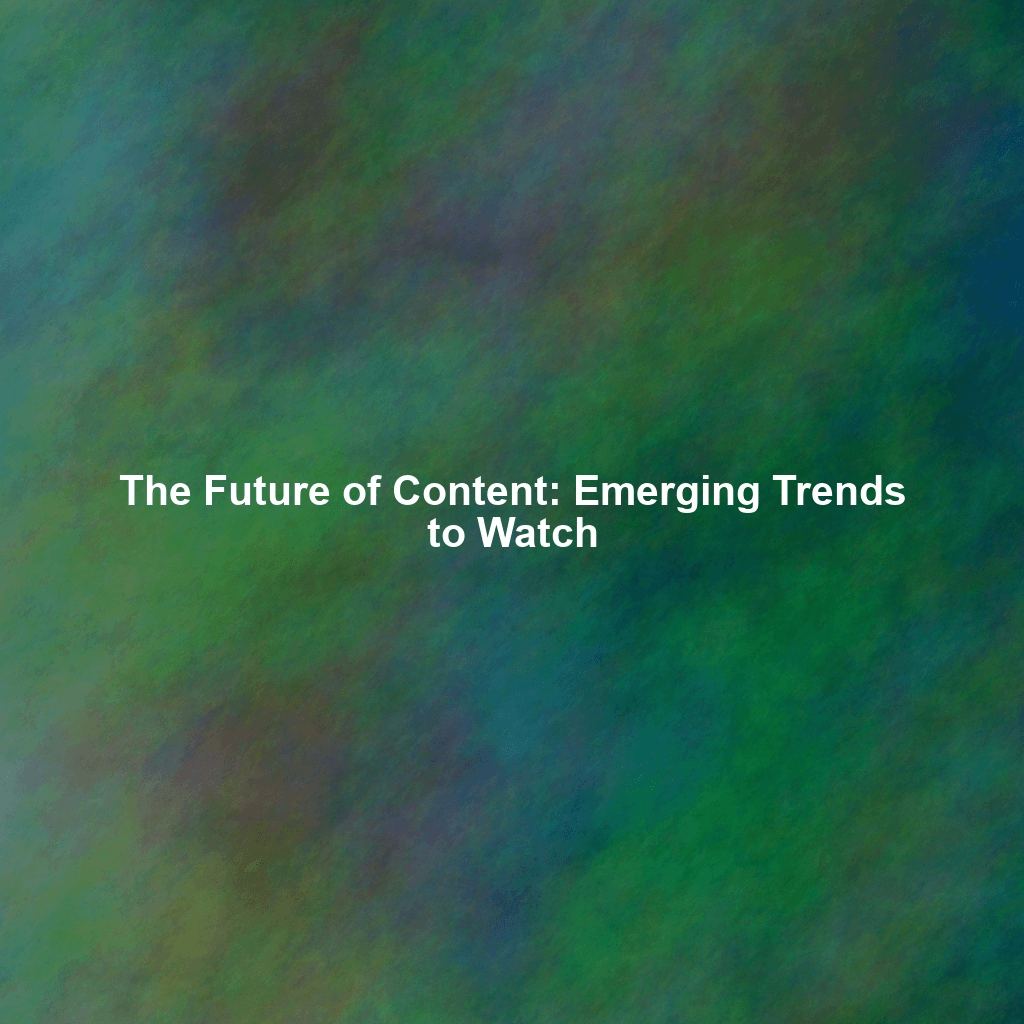The Evolving Landscape of Content Marketing
The world of content marketing is in a constant state of flux. What worked yesterday might not resonate today, and the strategies that will drive engagement tomorrow are already being shaped by technological advancements, evolving consumer behavior, and the sheer volume of information vying for attention. Staying ahead of the curve means understanding not just the current best practices, but also the emerging trends that are poised to redefine how we create, distribute, and consume content. This article delves into the key trends shaping the future of content, offering valuable insights for marketers looking to thrive in this dynamic environment.
Personalization: The Key to Cutting Through the Noise
In an era of information overload, generic content simply doesn’t cut it. Consumers expect personalized experiences, and brands that deliver are the ones that will capture their attention and loyalty. Personalization goes beyond simply addressing a customer by name; it involves tailoring content to their specific interests, needs, and behaviors.
Data-Driven Personalization
The foundation of effective personalization lies in data. By leveraging data analytics, marketers can gain a deep understanding of their audience, including their demographics, preferences, browsing habits, and purchase history. This information can then be used to create highly targeted content that resonates with individual users.
Dynamic Content
Dynamic content adapts to the user’s context in real-time. For example, a website might display different content based on the user’s location, device, or previous interactions with the site. This level of personalization creates a more engaging and relevant experience for the user.
Personalized Email Marketing
Email marketing remains a powerful tool, but generic email blasts are becoming increasingly ineffective. Personalized email campaigns, on the other hand, can deliver exceptional results. Segmenting your audience and tailoring your message to their specific interests can significantly improve open rates, click-through rates, and conversions.
The Rise of AI-Powered Content Creation
Artificial intelligence is rapidly transforming the content marketing landscape, offering marketers new tools and capabilities to create, optimize, and distribute content more efficiently. While the idea of AI replacing human creativity might seem far-fetched, AI-powered tools are already proving invaluable in automating repetitive tasks and enhancing the content creation process.
AI-Driven Content Generation
AI can be used to generate various types of content, including blog posts, articles, social media updates, and even video scripts. While the output might not always be perfect, AI can provide a valuable starting point and help marketers overcome writer’s block. Tools like Jasper.ai and Copy.ai are becoming increasingly popular for this purpose.
AI-Powered Content Optimization
AI can also be used to optimize existing content for search engines and user engagement. AI-powered tools can analyze content to identify areas for improvement, suggest relevant keywords, and even rewrite sentences to make them more engaging and readable. This can help marketers improve their search engine rankings and attract more visitors to their website.
AI for Content Curation
Finding relevant and engaging content to share with your audience can be time-consuming. AI-powered content curation tools can help automate this process by identifying articles, videos, and other resources that are relevant to your target audience’s interests. This can save marketers a significant amount of time and effort while ensuring that their audience is always informed and engaged.
Immersive Content: Engaging the Senses
In a world saturated with digital information, capturing and maintaining audience attention is more challenging than ever. Immersive content offers a powerful solution by engaging the senses and creating a more memorable and interactive experience. Technologies like virtual reality (VR), augmented reality (AR), and 360-degree video are transforming the way we consume content.
Virtual Reality (VR)
VR creates a completely immersive digital environment that users can explore and interact with. VR has numerous applications in content marketing, including virtual product tours, interactive storytelling, and virtual training simulations. While VR technology is still relatively expensive, it offers a unique and engaging way to connect with audiences.
Augmented Reality (AR)
AR overlays digital content onto the real world, creating a blended reality experience. AR has many practical applications in content marketing, such as allowing customers to virtually try on clothes, see how furniture would look in their home, or access interactive product information. AR is becoming increasingly accessible through smartphone apps and other devices.
360-Degree Video
360-degree video allows viewers to explore a scene from any angle, creating a more immersive and engaging viewing experience. 360-degree video is particularly well-suited for travel and tourism marketing, allowing viewers to experience a destination before they visit. It’s also being used in other industries, such as real estate and entertainment.
The Continued Dominance of Video Content
Video has been a dominant force in content marketing for several years, and its importance is only growing. Video is highly engaging, easily digestible, and can be used to convey complex information in a visually appealing way. The rise of platforms like TikTok and Instagram Reels has further fueled the demand for video content.
Short-Form Video
Short-form video, typically lasting less than a minute, is becoming increasingly popular, especially among younger audiences. Platforms like TikTok and Instagram Reels have made short-form video accessible to a wider audience, and brands are using it to create engaging and shareable content. Short-form video is ideal for quick tips, behind-the-scenes glimpses, and humorous content.
Live Video
Live video offers a real-time and interactive way to connect with your audience. Platforms like Facebook Live, Instagram Live, and YouTube Live allow brands to host Q&A sessions, product demos, and live events. Live video is a great way to build relationships with your audience and generate excitement around your brand.
Optimized Video SEO
With the increasing popularity of video, it’s more important than ever to optimize your videos for search engines. This includes using relevant keywords in your video titles and descriptions, creating compelling thumbnails, and transcribing your videos to make them more accessible to search engines and viewers. YouTube is the second largest search engine, so optimizing your videos for YouTube search is crucial.
The Growing Importance of Voice Search
Voice search is becoming increasingly prevalent as more and more people use voice assistants like Siri, Alexa, and Google Assistant. Optimizing your content for voice search is essential for reaching this growing audience. Voice search queries tend to be longer and more conversational than traditional text-based searches, so you need to adjust your content strategy accordingly.
Conversational Keywords
Focus on using conversational keywords that reflect the way people actually speak. This means incorporating long-tail keywords and answering common questions that your target audience might ask. For example, instead of targeting the keyword “best coffee maker,” you might target the keyword “what is the best coffee maker for home use?”
Schema Markup
Schema markup helps search engines understand the context of your content, making it easier for them to deliver accurate results for voice search queries. Implement schema markup on your website to provide search engines with structured data about your products, services, and content.
Local SEO
Voice search is often used for local searches, such as “find a coffee shop near me.” Optimizing your website for local SEO is crucial for reaching customers who are searching for local businesses using voice search. This includes claiming your Google My Business listing and ensuring that your website includes your address, phone number, and hours of operation.
The Evolution of SEO and Content Strategy
SEO and content strategy are inextricably linked, and the future of content marketing requires a holistic approach that considers both. SEO is no longer just about optimizing for keywords; it’s about creating high-quality, engaging content that provides value to your audience. Google’s algorithm is constantly evolving to prioritize user experience and reward websites that deliver relevant and informative content.
E-A-T: Expertise, Authoritativeness, Trustworthiness
Google’s E-A-T guidelines emphasize the importance of expertise, authoritativeness, and trustworthiness in content creation. Demonstrate your expertise by creating in-depth, well-researched content that is backed by credible sources. Build your authoritativeness by earning backlinks from other reputable websites and becoming a thought leader in your industry. Establish trustworthiness by providing accurate and up-to-date information and being transparent about your business practices.
User Intent
Understanding user intent is crucial for creating content that ranks well in search results. When someone searches for a particular keyword, what are they actually trying to achieve? Create content that directly addresses their needs and provides them with the information they are looking for. This will improve your search engine rankings and increase user engagement.
Mobile-First Indexing
Google now uses mobile-first indexing, which means that it primarily uses the mobile version of your website for indexing and ranking. Ensure that your website is mobile-friendly and provides a seamless user experience on all devices. This includes optimizing your website for mobile speed, using responsive design, and creating mobile-friendly content.
Conclusion: Embracing Change and Adapting to the Future
The future of content marketing is dynamic and ever-evolving. By understanding and embracing the emerging trends discussed in this article, marketers can position themselves for success in this rapidly changing landscape. Personalization, AI-powered content creation, immersive content, video marketing, voice search, and SEO are all key areas to focus on. By adapting your content strategy to these trends, you can create more engaging, effective, and impactful content that resonates with your audience and drives results.
 Skip to content
Skip to content

